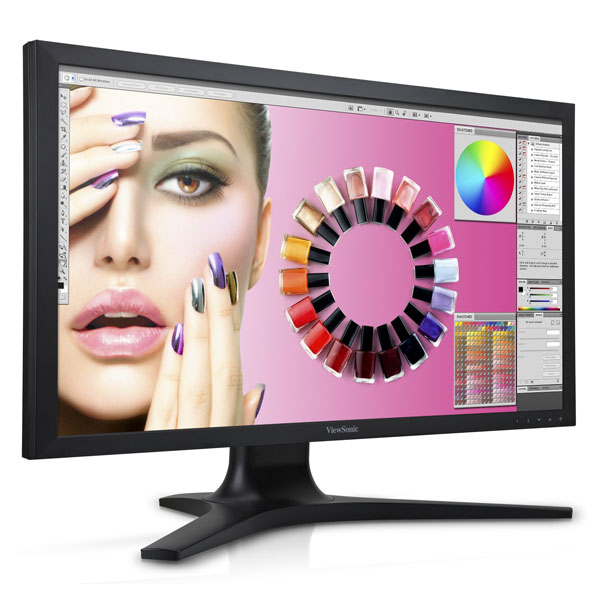ViewSonic VP2772 27-Inch QHD Professional Monitor Review
Today we’re testing the latest addition to ViewSonic's professional monitor line, the VP2772. This 27-inch screen offers QHD resolution; Adobe RGB and sRGB color gamuts; and 10-bit color with a 14-bit LUT. We see if its performance and specs match up.
ViewSonic VP2772: 27", 2560x1440, 10-Bit Color, And Adobe RGB
We spent quite a bit of time this month working with expensive Ultra HD monitors. But the sweet spot for pixel density versus value is still 2560x1440, called Quad HD. The prices on those screens remain higher than their 1920x1080 counterparts. However, they're quite a bit more affordable than first-gen 4K displays.
Because they cost more and often incorporate quality-oriented value adds, QHD panels often target graphics pros and photographers more than gamers, who typically want speed above all else. Instead, Photoshop jockeys are looking for accurate color and high-end video performance. When you're trying to match the color from camera to a monitor and printer, every link in that chain needs to conform to industry standards and have the ability to be adjusted.
The VP2772 is part of ViewSonic’s professional line that still includes the VP2770-LED we reviewed last year (VP2770-LED Vs. S27B970D: 27" Monitors At 2560x1440). We were impressed with that display’s performance, but lamented its lack of a wide-gamut option. The newer model checks that box. Unfortunately, it simultaneously ups the asking price by $230. Everyone wants to see QHD panels become more affordable, but the market’s downward trend has slowed to a crawl. In fact, high-res displays really aren't budging right now.
| Brand | ViewSonic |
|---|---|
| Model | VP2772 |
| MSRP | $1020 |
| Panel Type | AH-IPS |
| Backlight | GB-r-LED |
| Screen Size | 27-inch |
| Max Resolution | 2560x1440 |
| Max Refresh Rate | 60 Hz |
| Aspect Ratio | 16:9 |
| Native Color Depth | 10-bit (8-bit w/FRC) |
| Native Color Gamut | Adobe RGB |
| Response Time (GTG) | 12 ms |
| Brightness | 350 cd/m2 |
| Speakers | - |
| VGA | - |
| DVI | 1 |
| DisplayPort v1.2 | 1 standard, 1 mini, 1 out |
| HDMI v1.4 | 1 |
| Audio In | - |
| Headphone | 1 |
| USB v3.0 | 1 up, 4 down |
| Media Card Reader | - |
| Panel DimensionsW x H x D | 25.3 x 18.5 x 13.7 in643 x 470 x 348 mm |
| Panel Thickness | 2.1 in / 53 mm |
| Weight | 19.2 lbs / 8.7 kg |
| Warranty | Three years |
Obviously, the Adobe RGB gamut is an important element for graphics work. And having a display able to render Adobe RGB and sRGB with better-than two Delta E accuracy is critical. The VP2772 satisfies that requirement, and we're hoping this flexibility becomes a trend. I've tested Adobe-only monitors in the past and found them to be accurate. But the inability to switch to sRGB hampers their versatility. Playing games or watching video in Adobe RGB just doesn’t look right. Green, which the human eye is most sensitive to, always looks off. And when you look at the CIE chart, you can see why.
Another specification we haven’t touched on is bit-depth. The vast majority of IPS monitors, in all sizes, employ natively eight-bit panels. Regardless of the incoming signal's big depth, the panel can only render a maximum of 16.7 million colors. In high-end graphics, obviously, the more colors the better. ViewSonic's VP2772 adds frame rate conversion to increase its input bit depth to 10. Then it adds a 12-bit processing stage and a 14-bit look-up table to the signal output.
How does that improve image quality? Quite simply, the more colors a monitor can render, the smoother gradations between those colors will be. A wide dynamic range is fairly easy to achieve in a flat panel, but a smooth tone in the sky or in flame, for example, is much more difficult. That is the challenge of digital imaging. Film has an infinite number of shades within the confines of its color gamut; digital pictures do not.
We’ve spoken before about banding artifacts. These are easy to see on six-bit TN-based panels. You'll probably never notice them on a monitor like the VP2772 though, unless the original image is highly compressed. And with the 14-bit LUT to further increase the output signal's bit-depth, you should see the smoothest and most lifelike images possible on a fixed-pixel display.
Get Tom's Hardware's best news and in-depth reviews, straight to your inbox.
Current page: ViewSonic VP2772: 27", 2560x1440, 10-Bit Color, And Adobe RGB
Next Page Packaging, Physical Layout, And Accessories
Christian Eberle is a Contributing Editor for Tom's Hardware US. He's a veteran reviewer of A/V equipment, specializing in monitors. Christian began his obsession with tech when he built his first PC in 1991, a 286 running DOS 3.0 at a blazing 12MHz. In 2006, he undertook training from the Imaging Science Foundation in video calibration and testing and thus started a passion for precise imaging that persists to this day. He is also a professional musician with a degree from the New England Conservatory as a classical bassoonist which he used to good effect as a performer with the West Point Army Band from 1987 to 2013. He enjoys watching movies and listening to high-end audio in his custom-built home theater and can be seen riding trails near his home on a race-ready ICE VTX recumbent trike. Christian enjoys the endless summer in Florida where he lives with his wife and Chihuahua and plays with orchestras around the state.
